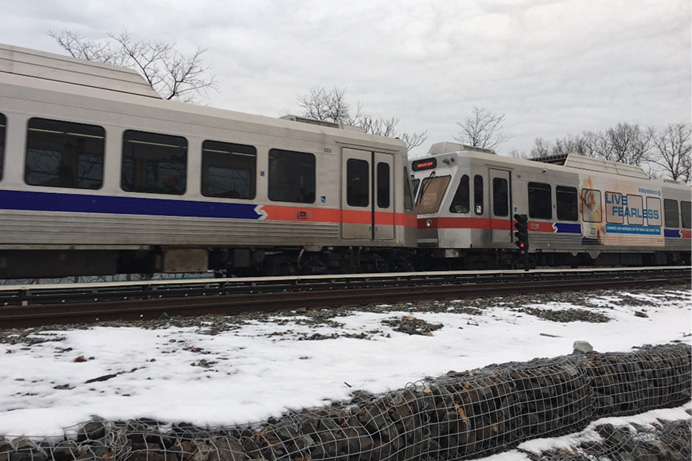
BY BRIAN BUTLER AND MARK GREGORY
Working around “moving” machinery occupied with numerous passengers presents various hazards to firefighters, especially since it’s the fire department that is summoned first during an emergency. We can no longer rely just on the experienced company officers and rescue personnel to recognize the dangers associated with these types of machines.
Elevators, trains, and automobiles transport millions of passengers every day. They are examples of “moving” machinery and are usually occupied with numerous passengers. The fire service must start identifying any machine that is passenger occupied and moving as “transportation” machinery, which would include elevators, escalators, passenger trains, and light rail.
“Target hazard” vehicles include buses loaded with passengers, heavy trucks, recreation vehicles (RVs) carrying propane, alternative fuel vehicles, car haulers, sanitation trucks, roll-offs, and school buses.
Vehicles transporting dangerous products or carrying the elderly and handicapped are additional types of high-risk transportation machinery that necessitate a thorough size-up during a fire, an entrapment, or both.
Even amusement parks and county fairs have moving machinery occupied with petrified children who may be stuck upside down on a ride.
Just because the fire department is the first to arrive doesn’t always mean mitigation is completely up to the firefighters. Those not trained or qualified should not be experimenting and relying on luck during these technical incidents. Fire service personnel must recognize that these incidents can and most likely will occur in their response areas. Training and preparation should be prerequisites to serving your communities fully while preventing injuries and mishaps to the victims and the responders involved.
Transportation Machinery
Between one and 100 passengers may occupy a transportation machinery car. Transportation machinery can be heavy, be unpredictable, and have various types of propulsion power.
They may release dangerous products and energy and can easily kill a complacent firefighter. Firefighters are more often around transportation machinery than industrial or agricultural machinery. They respond to calls for stalled elevators, car fires, and vehicle accidents with entrapment.
Let’s look at some common types of machinery firefighters deal with daily and the hazards associated with them.
Elevators
Elevators can be extremely dangerous. Although 95 percent of the fire department response is a routine passenger removal without incident, this can lead to complacency. Just shutting off the power and then opening a hoistway door near the landing to remove passengers does not make firefighters elevator experts. How far will some firefighters go without extensive training by professionals in the elevator industry?
If firefighters arrive at a stalled elevator call and notice obvious damage to an elevator hoistway door with 25 stories of unprotected open shaft below the car, will they wait for the elevator representative? What dangerous risks would an inexperienced company officer take trying to extricate a few passengers from an unstable elevator damaged during a natural gas explosion in a high-rise apartment building?
There are also dangers present in the elevator machine room (EMR) that can be extremely hazardous to those not familiar with motors, high voltage, shaft vents, and other dangers lurking there.
Working in the hoistway is the most dangerous where moving counterweights and fall hazards are present. Sizing up this machinery is critical for the safety of the passengers and firefighters. Damaged ropes, hoistway doors, smoking belts, difficult extrications, and sudden unexpected movement of an elevator car are signs that the experts should be called. Keep in mind that once you shut down power to the elevator car, you become the brain of that elevator.
Your lack of knowledge of the system’s design features can have disastrous results. For example, the fire department responds to a “space case emergency” in which a person’s foot is stuck between the landing and the elevator car. Most rescuers, after completing lock-out/tag-out, would use one of many tools to lift the elevator car just enough to release the victim.
Although this sounds like a routine operation, the results could be disastrous. The elevator’s safety systems feed information to its “brain.” Although locking out the elevator allows you to have control, remember that every action has a reaction; this may release the safeties within the car and cause it to drop or fall. You must consider supporting the elevator manually as a secondary safety system. A manual hoisting device secured to a high point within the shaft has been used successfully to safely and effectively capture and secure any elevator car movement.

(1) Elevators and escalators transport millions every day. Most elevator incidents involve passengers stuck in a stalled car. Escalator incidents usually involve entanglement of clothing, falls, and hand and foot entrapments, especially with children. (Photos by Brian Butler unless otherwise noted.)
![Rescue companies often train for high-risk/low-frequency elevator rescues that involve “blind shafts” that do not have openings on each building floor and other hoistway emergencies. [Photo by Captain Michael Burzachiello, Trenton (NJ) Rescue One.]](/wp-content/uploads/2019/09/1909FE_Butler-p02.jpg)
(2) Rescue companies often train for high-risk/low-frequency elevator rescues that involve “blind shafts” that do not have openings on each building floor and other hoistway emergencies. [Photo by Captain Michael Burzachiello, Trenton (NJ) Rescue One.]
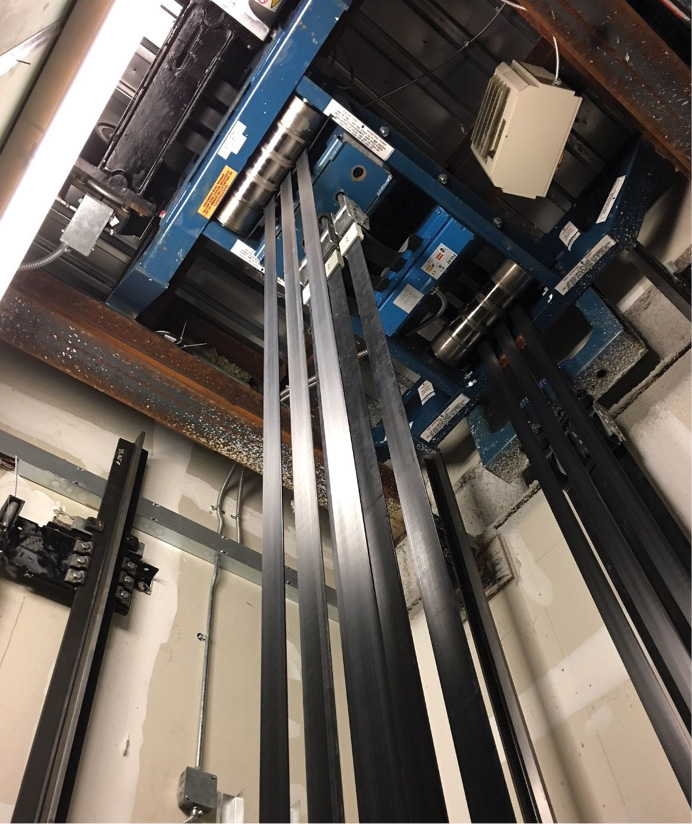
(3) Elevator size-up includes first determining its type (freight, passenger) and its propulsion (e.g., hydraulic, electric), which can help determine the elevator machine room location. The components for newer machine roomless elevators pictured here may be located anywhere—inside the hoistway and outside in the lobby wall. Consider the elevator shaft fall hazards. Leaning into an elevator hoistway can be fatal for a complacent firefighter. Untrained fire personnel should not attempt to lower a hydraulic elevator or perform a top hatch removal with passengers who are already safe inside the elevator. Only highly trained fire-rescue members and elevator representatives working together should perform this dangerous task. Securing the main power to the stalled car and the adjacent car and providing fall protection for passengers and firefighters should be mandatory. Counterweights moving up and down in the hoistway can kill rescue workers and passengers in the shaft. Inexperienced firefighters relying on luck and taking unnecessary risks are acting irresponsibly, creating a dangerous and potentially deadly disaster with huge liability issues.
Trains
Some fire departments have rapid transit running through their response areas. Whether high-speed, commuter, or light rail service, they are perfect examples of large, dangerous transportation machinery. Freight trains carrying thousands of gallons of diesel fuel sometimes run through rapid transit territory underneath high-voltage catenary lines, which is very dangerous during a locomotive or a tank car fire. Trains are powerful heavy machines that move at high speeds, some more than 100 miles per hour. Passenger rail cars weigh up to 70 tons, and locomotives more than 100 tons.
In addition to the dangers of pin and crush injuries at platforms and collisions at rail crossings, passenger trains bring the possibility of electrocution. Whether it’s a 12,000-volt alternating current (AC), an overhead catenary wire, or a 750-volt direct current (DC) third rail, there’s enough current around these trains to kill firefighters who are carelessly operating hose streams and otherwise coming in contact with a third rail or live catenary wire.

(4) It is extremely important to size up passenger trains to determine the track territory and the propulsion method since there are many hazards along the right of way. The electric commuter train here operates on 700 volts of direct current from the third rail (arrow) under a protective cover.
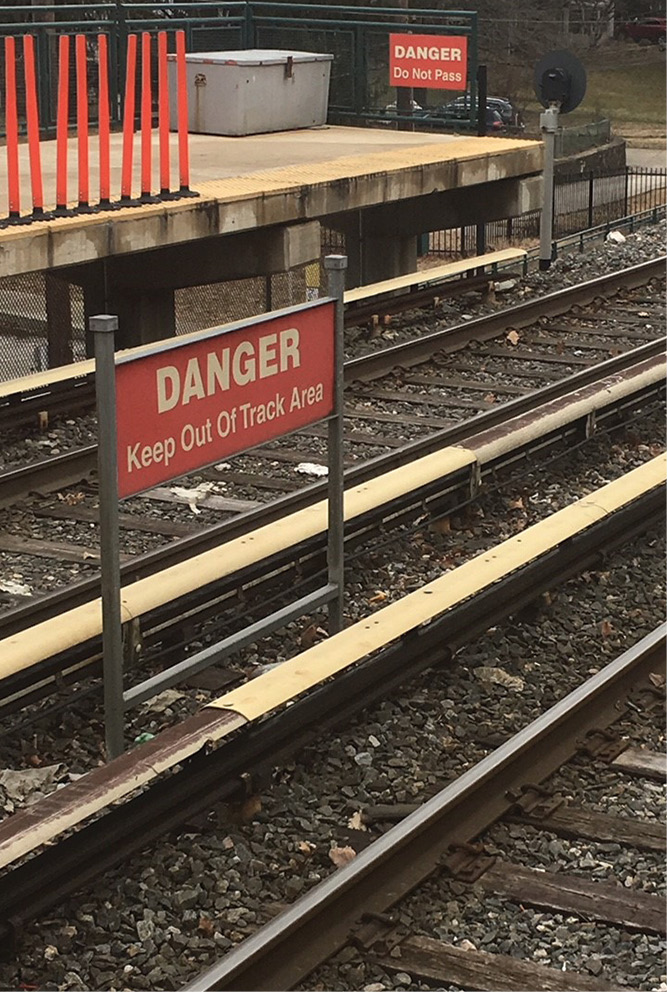
(5) Contacting the third rail can be fatal.
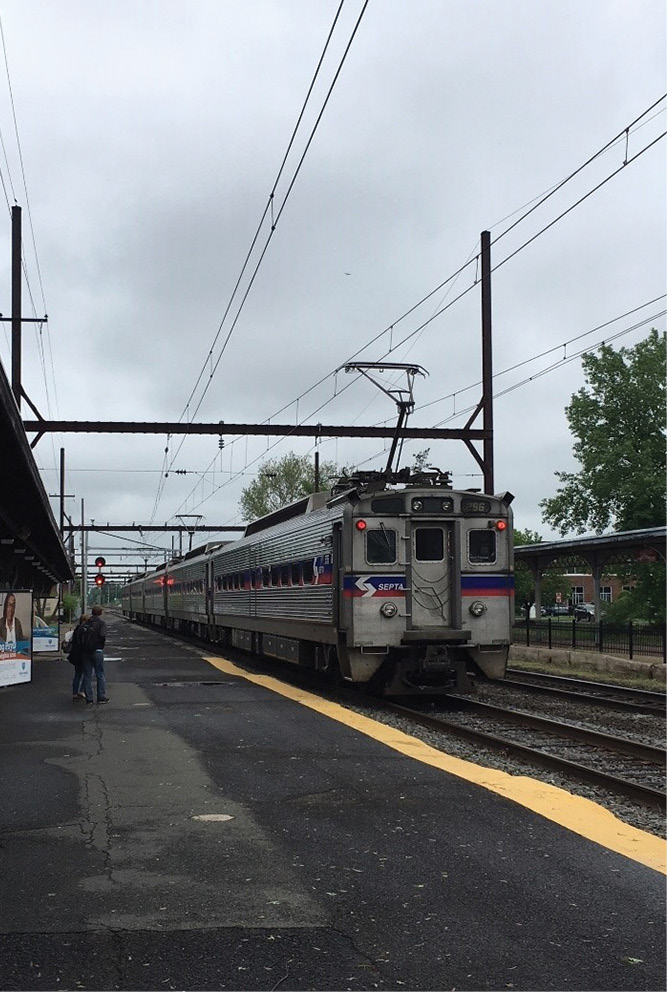
(6) Overhead catenary wires identify electrified territory.
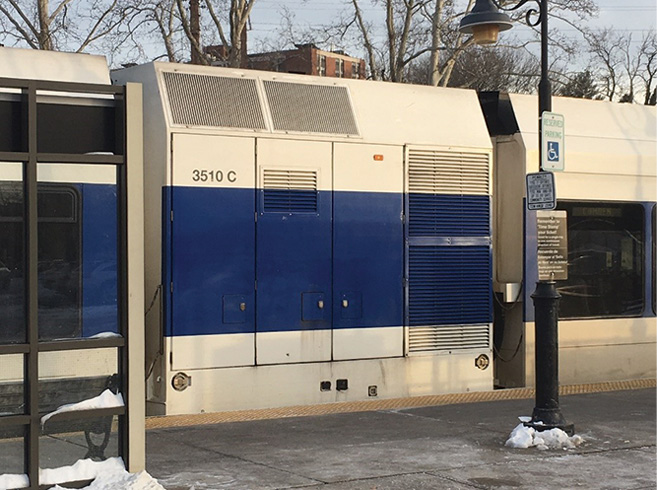
(7) There are no overhead catenary lines or third rail on the New Jersey River line; it runs on former freight tracks and is open nonelectrified territory. This light rail train uses diesel multiple units for power. During the size-up, this means that several electrical hazards will be absent.
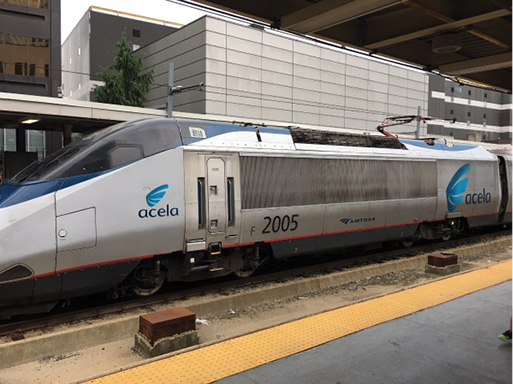
(8) The Amtrak Acela train is powered by an electric locomotive and moves at more than 100 miles per hour. The pantograph on top of the locomotive draws its power from the overhead catenary wire carrying 12,500 volts of alternating current. Identifying the type of locomotive is critical, especially during rail crossing collisions. Freight and some passenger train locomotives may carry up to 5,000 gallons of diesel (diesel locomotives). “Dual” locomotives may travel in electrified and nonelectrified territories. They have the ability to switch from diesel-electric power to strictly electric power (third rail, pantograph, and catenary). Dual locomotives carry diesel fuel for the engine that drives the generators to power the traction motors. Preplan your territory!
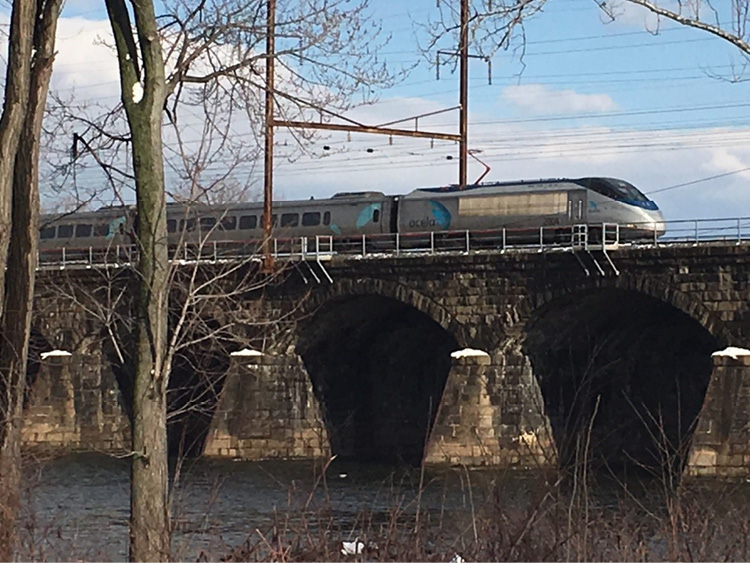
(9) An Amtrak Acela train crossing the Delaware River from Trenton, New Jersey, to Pennsylvania. The size-up for this train should include that it is an “Amtrak high-speed passenger train with an electric locomotive in electrified territory on a bridge over water” followed by the type of emergency (e.g., fire, derailment). This will help determine the type of additional resources needed, the proper command center, and the emergency management contact for removing power and stopping the train.
Some trains with diesel locomotives may have up to 5,000 gallons of diesel fuel in their tanks.
For fires, derailments, collisions, and other incidents, the location is another challenge. Trains travel on bridges, over water, underground, through tunnels, and on elevated platforms. You must perform a size-up before beginning suppression or rescue. Whatever the emergency, first determine how the train is powered and whether the emergency is in a passenger car or the locomotive. Is it near electrified rail territory? Can emergency vehicles access the area? What is the procedure to deenergize and stop movement on adjacent tracks? Depending on the incident’s severity, identify the risks to which untrained and unfamiliar firefighters may be exposed.
Man-under-train incidents occur all across the United States. As rescuers, you must ensure during the initial size-up the “risk vs. reward factor.” Is the victim under the train dead or alive? A dead victim is no longer a rescue; a less urgent approach is appropriate. If the victim is still alive, contact the victim to ensure he limits his movements under the train and near any dangerous electrical currents. Would-be rescuers should always consider why this victim is in this predicament. Is this an accident or a failed suicide attempt? Could the victim “lure in” the rescuers and make them additional casualties? Train personnel are highly trained on their equipment; rescuers should take advantage of the knowledge and resources they can provide.
Automobiles
Fires and accidents necessitating extrication demand a quick detailed vehicle size-up, especially at fires with entrapment that need a rapid rescue. You can do most of the size-up looking through the windshield on approach, noting the important factors the scene is giving you.
The officer arriving first due on an understaffed engine company to a vehicle fire with entrapment or a potential explosion with lives at stake must make a fast scan of the scene and critical decisions. A three-person crew will have to start with good apparatus placement, traffic control, additional resources requests, and creative rescue tactics if equipment and staffing are lacking. They will have to identify and mitigate the dangers in front of them. Water supply issues on the roadway necessitate water discipline during suppression. The newest vehicles now use laminated windows on the entire vehicle, rendering the hole punch and halligan strike useless. What’s Plan B? Many rules and standard operating procedures (SOPs) will go out the window; personnel may have to perform numerous tasks simultaneously to achieve success. The size-up will determine the best actions to take.
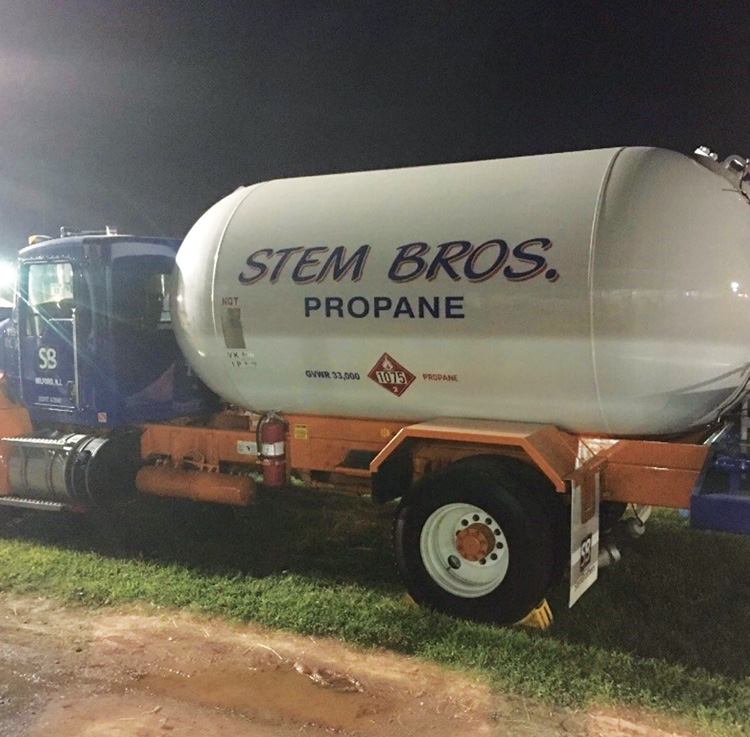
(10) Propane trucks with 1075 (explosive gas) placards (circle) are “target hazard” vehicles.
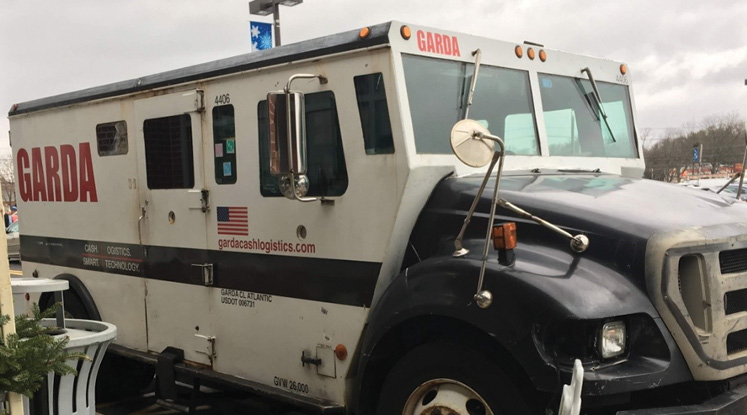
(11) Armored vehicles are heavy and can be extremely difficult when it comes to extrication. These trucks are rolling vaults and usually have an armed guard in the back.
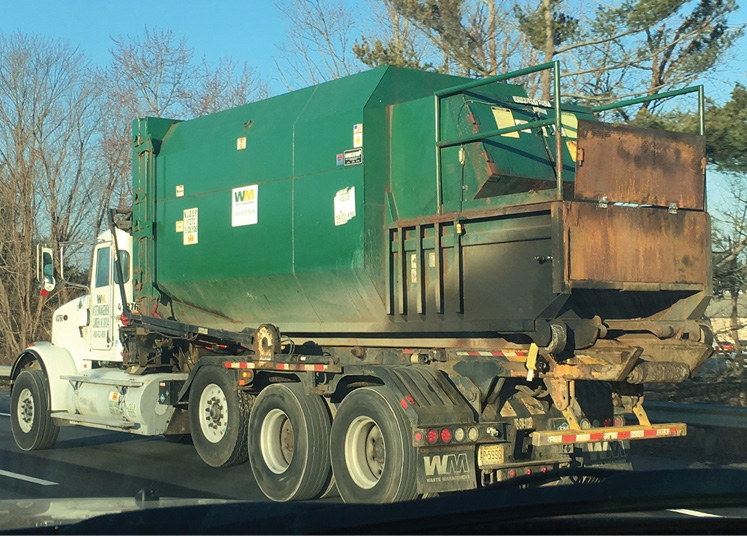
(12) Roll-off compactors are dangerous heavy moving machinery responsible for fatalities and crush injuries. Consider stabilization and possible winch failure during the accident and exposed straps and hydraulics during fire. On September 30, 2016, a 26-year-old laborer working at a charitable donation warehouse died when he was crushed between a trash compactor and an empty roll-off receiving container a truck was unloading.
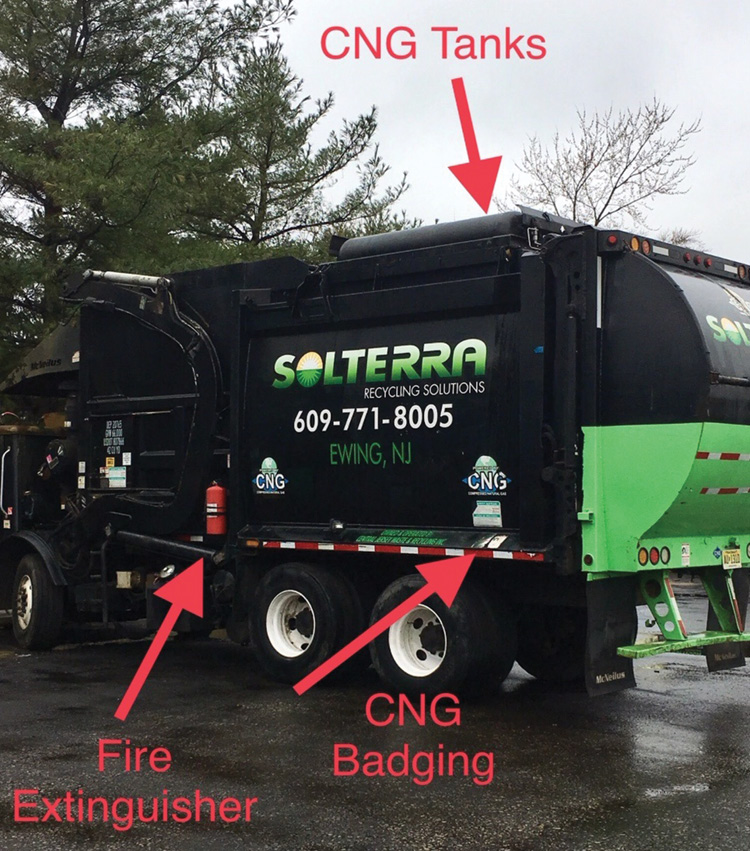
(13) This sanitation truck runs on compressed natural gas (CNG). Other CNG clues include the cylinder housing and CNG badge. Consider CNG and hydraulics when these trucks are burning or involved in accidents. If the sanitation truck is burning, determine if the fire is confined to the hopper or to the cab or if fire is underneath the truck.
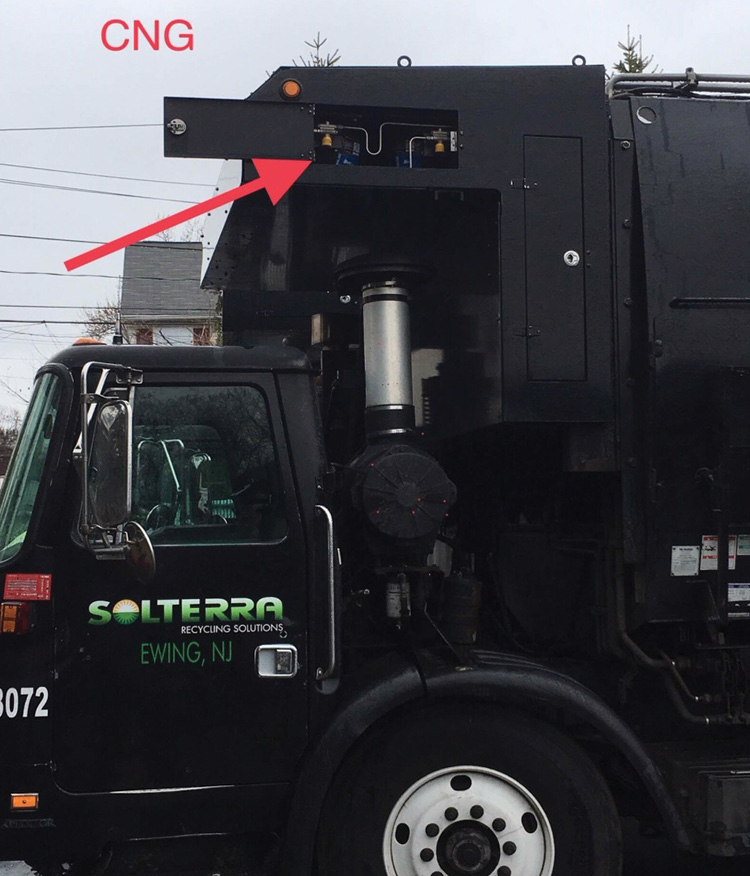
(14) Most CNG tanks are on the roof or behind the cab, so you must identify and mitigate any exposure issues. Activated relief valves are warnings that the pressure is increasing. These trucks also have compactors. Many homeless people who have fallen asleep in dumpsters have been dumped inside the hopper and been pinned or crushed to death by the compactor, requiring a technical rescue response.
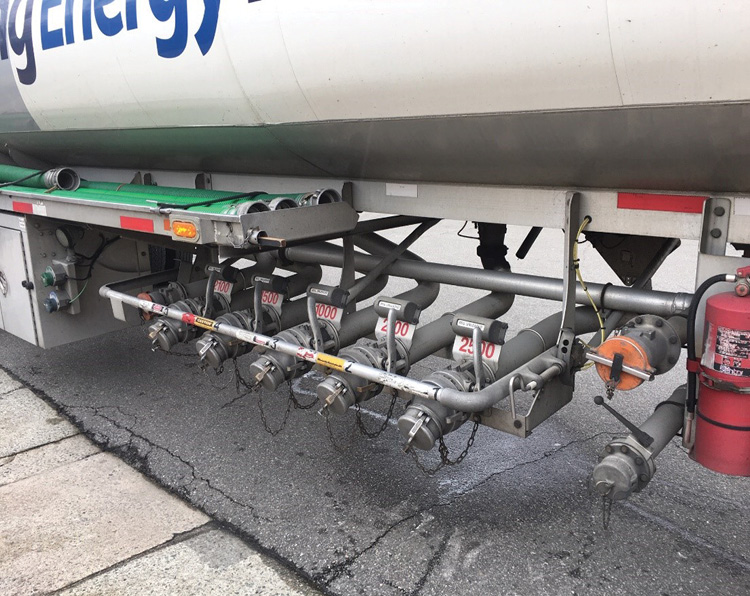
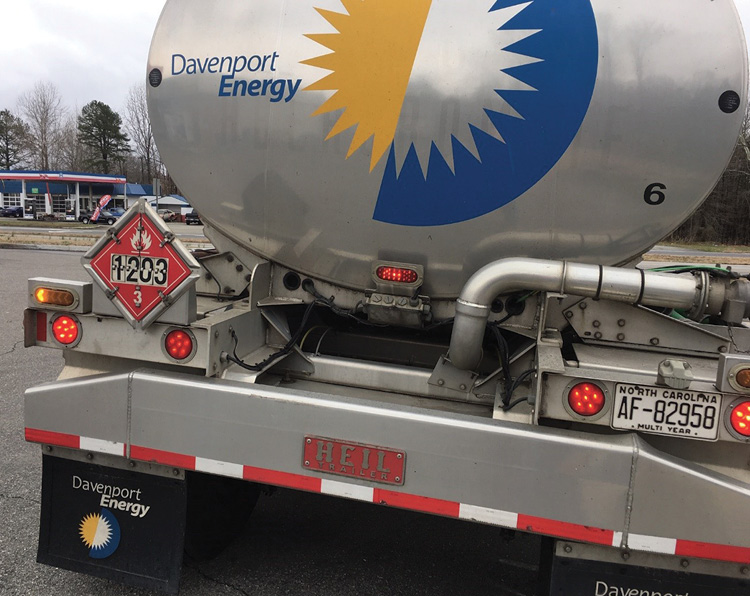
(15-16) Vehicles carrying flammable liquids (1203 placard) are major target hazards. A side impact underride followed by fire can be disastrous even with this truck’s built-in safety features.
Firefighters should preplan responses to such incidents so they are better prepared. Understanding the benefits and limitations of your rescue arsenal separates the “street smart” firefighter from the average one. Understanding the spreading points, the cutting points, and the operating areas will expedite safe disentanglements. Always consider “outside the box” options in fire rescue.
Vehicle vs. pedestrian accidents occur every day. When a victim is trapped under the vehicle, often air bags are used. But consider the time and space they need; time is critical in these incidents. Are these tools on your apparatus? Other options can provide safe and effective results in a fraction of the time; they include the bottle jack, the spreader lift, and the fulcrum point or “ladder lift.”
Target Hazards
Consider technical rescue involving other specific “target hazard” vehicles such as sanitation vehicles with compactors and trailers with wood chippers that may require disentanglement or recovery operations.
Fires involving recreational vehicles, food trucks, ambulances, compressed natural gas-powered transit buses, car haulers, and landscaping trucks all have the potential for intense fires, explosions, and projectiles.
Accidents with entrapment involving heavy vehicles such as armored trucks, school buses, and cement trucks will need advanced stabilization.
Passenger-occupied machinery extrications can be dangerous. Responders may encounter high voltage, hydraulics, stored energy, flammables, explosives, running fuel, malfunctioning equipment, moving parts, heavy equipment, and falls. Firefighters must be trained to recognize these potential hazards as well as participate in skill sets that will enhance their abilities to safely extricate victims and mitigate the situation successfully. On-site walk-throughs and training for “man vs. machinery” extrication and elevator rescue operations are excellent opportunities for familiarizing personnel with the various types of machinery while they learn proven tactics and tool options to get the job done.
The fire service must recognize the liability issues of untrained firefighters attempting to perform rescues and fire suppression around dangerous complex moving machinery. Just because the fire department arrives first on scene does not mean it alone is responsible for complete incident mitigation. Fire departments must use the resources available to educate and keep personnel safe.
References
California Department of Public Health Occupational Health Branch. Fatality Assessment and Control Evaluation Program (CA/FACE). “A Laborer is Crushed Between a Trash Compactor and Receiving Container.” Case Report 16CA004. April 7, 2017. https://bit.ly/2ZmzUuz.
Eyewitness News ABC7NY. (February 26, 2019) “NYC subway escalator buckles, shreds during morning commute.” https://bit.ly/2MsFKXU.
The Morning Call. (March 13, 2015). “Allentown homeless man crushed to death in back of garbage truck.” https://bit.ly/2yq9egA.
BRIAN BUTLER is a captain and 22-year veteran of the Trenton (NJ) Department of Fire and Emergency Services. He worked for 15 years on an engine company and seven years on a ladder company. He has been assigned to every station in the city, having worked on all four truck companies and seven engine companies. He is a member of King of Prussia (PA) Fire Rescue and a hazmat technician and a rescue technician with the Southeastern Montgomery County (PA) Technical Rescue Task Force. He is a level 2 fire instructor. Butler is the owner of UrbanFireTraining.com.
MARK GREGORY is a 32-year veteran of the fire service, a 28-year member of the Fire Department of New York (FDNY), and the captain of Ladder 176. He previously was a captain on Tower Ladder 142, Divisions 13 and 15; a lieutenant in Tower Ladder 111; and a firefighter in Rescue 2 and Ladder 132. He instructs at the FDNY and Suffolk County Fire Academies and is a national lead instructor with P.L. Vulcan Fire Training.

